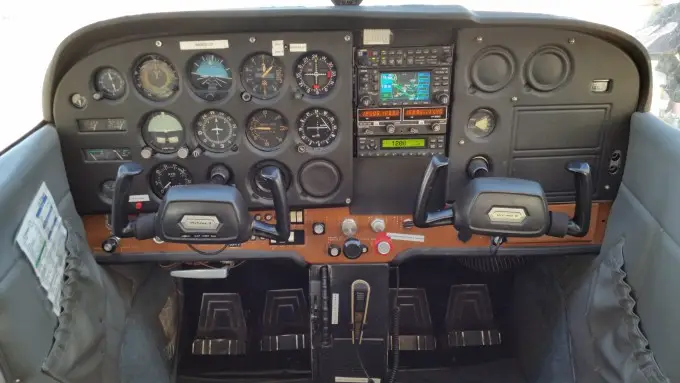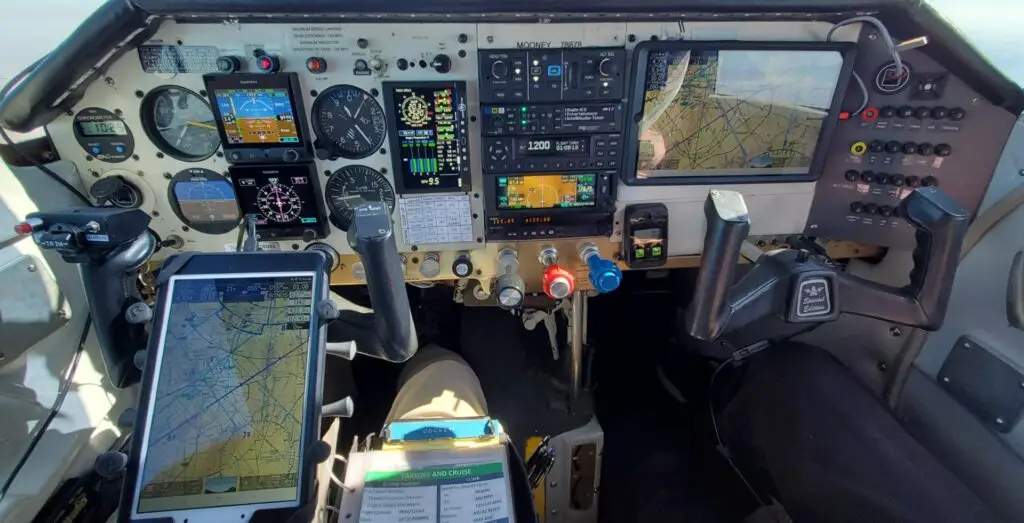September 29, 2021
More than a year in the making, the day was finally here. I began studying for the written portion of the IFR Exam August 20, 2020. After a few months of study I gave myself a deadline to take the written and scheduled it for December 22, 2020, scoring a 92%. I began the flying portion February 20, 2021.
I had 41.4 hours of Actual/Simulated Instrument time and felt good about my abilities to fly in the IFR system. The only monkey wrench getting tossed in was that I would be flying a Cessna 172 for the check-ride instead of my Mooney. With 35.8 hours of Actual/Simulated Instrument time in my Mooney I could fly the approaches well, I had all of my power settings for different phases of flight, and I knew my radio backwards and forwards. With a grand total of 6.5 hours in a Cessna 172 (not counting 2 hours in 2018 in Maui) and only 5.6 Actual/Simulated Instrument time I was not as refined in the Cessna.
I am sure you are asking why I would choose to take the check-ride in the Cessna. My Mooney has a WAAS GPS in the panel which is certified for all portions of IFR flight. However, the Appendix of the ACS (Airman Certifications Standards) for the Instrument Rating states that the three approaches to be flown during the check-ride must use two different types of navigational aides. Although my plane is approved for IFR flight, it doesn’t meet the requirements for the check-ride.


One of the reasons I waited to start my IFR training was because I wanted GPS in the panel and glass displays with no vacuum system. Pilots have been flying IFR with vacuum gyros and no GPS for a very long time, but I want as much stacked in my favor as possible. With the G-5’s I have everything I need right in front of me on two instruments. I can set a heading bug to aid with maintaining course. The deviation indication is on the HSI and there is no precession of the instrument because it gets course information from a magnetometer. There is an altitude bug that can be set to help maintain assigned altitudes and it gives you audible alerts when 1,000′ and 200′ from the bugged altitude. If you deviate from the altitude by 200′ after reaching it there is an audible and visual alert. All of these help with IFR flying, and the Cessna had none of these aides.
Finally, on the subject of simplifying and added safety for IFR flying I had a GFC500 autopilot installed in May. It is an incredibly capable autopilot, and even when it is not active still provides envelope protection to prevent over-speed, under-speed, and over-banking.
I flew the Cessna out to Corona Tuesday evening so that I wouldn’t have to worry about getting stuck by the marine layer that had been hanging around the previous few days. As it would turn out, Wednesday morning would dawn beautifully without a cloud to be found in the LA Basin and just a bit of haze and low clouds in the Inland Empire affecting some of the airports but not Corona. It was still nice to not have the stress of worrying about whether I could fly to my appointment or not.
My wife dropped me off at the airport and I met the DPE (Designated Pilot Examiner). He went through my log book and the airplane log books to make sure that both myself and the airplane met the requirements for the exam.
The check ride has two parts, the oral part and the practical part. In the oral you are answering questions about rules/regulations/procedures/weather/etc to show you know what you need to know. In the practical part you are flying the plane to show that you can fly the procedures. After verifying everything it was time to begin the oral exam.
During the oral there was time spent on some of the things that you have memorized, but a good portion of the exam was scenario based. The DPE is so much interested in finding out if you memorized a bunch of stuff as finding out if you understand what you learned and how to apply it to real world situations.
On his instructions I had planned and filed an IFR flight from Corona (KAJO) to Bakersfield (KBFL). When I got the weather briefing for the flight that morning I printed off the complete briefing. He had asked for notes to be taken on the briefing but having the actual briefing worked better as we just went through it with him asking me questions about the different parts and “what if” questions.
There were a few questions that stumped me, and one that I got wrong technically but right for my plane. The question was if I got to the plane and found that the #2 radio wasn’t working could I still legally make the IFR flight.
“No,” I said.
“Are you sure?” Was his response.
I was thinking in my mind I was sure, but when you give an answer and get that “You sure” with a questioning look on the examiner’s face you think, “Well I was sure when I gave the answer two seconds ago but now you have me second guessing myself.”
He had me open up the FAR/AIM where it reads in 91.205(d)(2) “Two-way radio communication and navigation equipment suitable for the route to be flown.” Nowhere does it say that you must have two radios. There was a little discussion about what is “legal” and what is “prudent,” and flying IFR with one radio falls into the “legal” but “not prudent” category. I explained that the reason I thought two radios were required is because per installation requirements for the GNC355 that is in my Mooney a second radio is required for IFR flight.
There were a few other things I stumbled around on, so there was some relief when he wrapped up the oral portion by saying “Good job, let’s go flying.”
He briefed the flight with me and the different possibilities depending on whether we could get SoCal Approach to give us flight following or not. After taking off from Corona I would fly a heading of 100 to intercept the V186 airway which would put us out over Lake Matthews. At that point we would do a couple of unusual attitude recoveries. Next, I would call up ATC for flight following. We would fly the ILS into Chino with a touch-n-go, then back around for the Localizer into Chino. After going missed on that approach we would fly to the Paradise VOR, enter and fly a complete lap in the hold, then the GPS-A approach back to Corona and circle to land.
If Approach was too busy he would coordinate with the Riverside Tower to navigate their airspace and play the part of ATC on the radio giving me vectors to fly the approaches. If that didn’t work because Riverside Tower was too busy then we would go fly approaches at March ARB where they are always happy to help out, we just wouldn’t be able to put the wheels on the runway.
We walked down to the plane where I did my pre-flight on the plane and he did his own pre-flight on it as well. I had never considered that the life of a DPE involves getting into different planes everyday that they don’t know anything about other than the log book entries. Yes, the plane flew there, and yes the log books looked good, but that doesn’t mean there aren’t hidden issues that could cause a safety of flight concern.
With both of our pre-flights complete we climbed in and I went through the checklist to start up the plane. We taxied to the run-up area and I went through the checklists to perform the runup and configure the plane prior to taking off.
After taking off he took the controls while I put the foggles on. Once taking control of the plane back I turned to a heading of 100 and proceeded to climb to 3000′ heading toward an intercept of V186. Maintaining a heading with an old school directional gyro and no heading bug while scanning all the other instruments is not as easy as with the G5’s.
The unusual attitudes were easy. The first time he gave me the plane back we were in a climbing right turn with airspeed degrading. I pushed power in, rolled wings level, and pushed the nose down to recover. The second time he gave me the plane back we were in a descending right turn. I pulled power out, rolled wings level, and pulled back on the yoke. Once we were out of the descent the power went back in and I brought us back up to the original altitude.
Next up it was time to call ATC and go fly the approaches. Multiple calls to ATC got no response, so he took the radio and called up Riverside tower to coordinate flying through their airspace. The ILS went well, tracking it all the way down and using radials off the Paradise VOR to identify the fixes on the approach. When we got to the decision altitude he said “runway in sight,” the signal to take off the foggles and continue to the landing. I was supposed to touch down on the 1,000′ markers but landed long by about 100′.
After a short roll I pushed the throttle back in and we took off again. We began climbing out and once the control tower cleared our left turn the DPE gave me vectors while he called up Riverside Tower to transit their airspace again.
Riverside Tower responded with, “Give SoCal another try, they just opened a new sector so should be able to help you. If not contact me again.”
Sure enough, this time Approach had time for us and so the radios were back in my hands. As we intercepted the Localizer I “lost” my vacuum pump courtesy of a couple of yellow post-it notes over the attitude indicator and the directional gyro. The Cessna has a regular compass in it instead of a vertical compass card like my Mooney which means it reads backwards, requiring a little more brain-power but I was able to track the localizer in and didn’t bust any crossing altitudes.
After descending down to the MDA (Minimum Descent Altitude) I leveled us off and we motored along until I told him we were at the missed approach point. He said we couldn’t see the runway (shocker) so I added power and began climbing out. The tower had instructed me to fly runway heading on the miss and that he would call my left turn so I continued the climb, maintaining the heading until he said “Cessna 238, left turn approved, contact SoCal.”
I tracked a course back to the Paradise VOR and after crossing over it I made a parallel entry to the hold and then one full turn. In my plane the GPS does all the work for you, telling you when to turn and the heading to turn to. In the Cessna it depicts the hold, but you have to time everything yourself, so I made sure to note the time on the clock for each leg. On the outbound leg, Approach asked how much longer before I turned inbound. I glanced at the clock and told him “Fifteen seconds.” We were cleared for the approach and once crossing the VOR inbound I made the turn and began the descent. I let him know that we were at the missed approach point and he said “Airport in sight” which meant I could take off the foggles.
There were a couple other planes in the pattern so instead of just crossing over mid-field I flew an upwind leg and then entered the pattern behind the second plane. We came around and landed, and it was a pretty good one if I do say so myself, especially considering it was just my 7th landing ever in a Cessna. We taxied over and shut down in front of his hangar, he reached over to shake my hand and said “Good job.”
When we landed, I honestly wasn’t sure if I had passed or not. I felt like I was behind the plane quite a bit of the time and I fumbled with the radio some as well. I know that they aren’t looking for perfection, just that you meet the standards in the ACS. I had made a couple of errors and corrected for them, so I think the reason he still passed me was because I caught them and verbalized what was happening and what I was doing to correct it.
Back in his office we went through a post flight briefing, finished up paper-work, and he gave me my new temporary certificate. Unlike when I got my PPL (Private Pilot’s License) there were no post-flight pictures with the DPE and my instructor. As I flew back to Fullerton and for the rest of the day I kept thinking, “I can’t believe I’m done.” It has been long journey and I’m grateful to have accomplished it and the additional knowledge and skills I have gained along the way. Now to go find some clouds to fly through.



